List of World Heritage Sites in Turkey

The United Nations Educational, Scientific and Cultural Organization (UNESCO) World Heritage Sites are places of importance to cultural or natural heritage as described in the UNESCO World Heritage Convention, established in 1972.[1] Turkey accepted the convention on 16 March 1983, making its historical sites eligible for inclusion on the list. As of 2023, there are 21 World Heritage Sites in Turkey, including nineteen cultural sites and two mixed sites.[2]
The first three sites in Turkey, Great Mosque and Hospital of Divriği, Historic Areas of Istanbul and Göreme National Park and the Rock Sites of Cappadocia, were inscribed on the list at the 9th Session of the World Heritage Committee, held in Paris, France in 1985.[3] The latest inscriptions, Gordion and Wooden Hypostyle Mosques of Medieval Anatolia, were added to the list in 2023.
World Heritage Sites
[edit]- Site; named after the World Heritage Committee's official designation[4]
- Location; at city, regional, or provincial level and geocoordinates
- Criteria; as defined by the World Heritage Committee[5]
- Area; in hectares and acres. If available, the size of the buffer zone has been noted as well. A value of zero implies that no data has been published by UNESCO
- Year; during which the site was inscribed to the World Heritage List
- Description; brief information about the site, including reasons for qualifying as an endangered site, if applicable
| Site | Image | Location | Criteria | Area ha (acre) |
Year | Description |
|---|---|---|---|---|---|---|
| Aphrodisias | 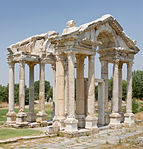
|
Aydın Province 37°42′30″N 28°43′25″E / 37.70833°N 28.72361°E |
Cultural: (ii)(iii)(iv)(vi) |
152 (380) | 2017 | The site consists of Aphrodisias itself (featuring the 3rd-century BCE Temple of Aphrodite) and the ancient marble quarries nearby, which had brought wealth to the ancient Greek city.[6] |
| Archaeological Site of Ani | 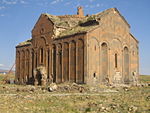
|
Kars Province 40°30′00″N 43°34′00″E / 40.50000°N 43.56667°E |
Cultural: (ii)(iii)(iv) |
251 (620) | 2016 | Located close to the Turkey-Armenia border, the medieval city of Ani reached its golden age in the 10th and 11th centuries as the capital of Bagratid Armenia, before going into decline from the 14th century on following a Mongol invasion and a major earthquake.[7] |
| Archaeological Site of Troy | 
|
Çanakkale Province 39°57′23″N 26°14′20″E / 39.95639°N 26.23889°E |
Cultural: (ii)(iii)(vi) |
158 (390) | 1998 | Dating back to more than four millennia ago and serving as a key influence on Homer's Iliad and Virgil's Aeneid, Troy was rediscovered by Heinrich Schliemann in the late 19th century, and has since become one of the most well-known archeological sites in the world.[8] |
| Arslantepe Mound | 
|
Malatya Province 38°22′55″N 38°21′40″E / 38.38194°N 38.36111°E |
Cultural: (iii) |
74.07 (183.0) | 2021 | Arslantepe was an ancient city on the Tohma River, a tributary of the upper Euphrates rising in the Taurus Mountains. It has been identified with the modern archaeological site of Arslantepe near Malatya. The first swords known in the Early Bronze Age (c. 33rd to 31st centuries) are based on finds at Arslantepe by Marcella Frangipane of Rome University.[9] |
| Bursa and Cumalıkızık: the Birth of the Ottoman Empire | 
|
Bursa Province 40°11′05″N 29°03′44″E / 40.18472°N 29.06222°E |
Cultural: (i)(ii)(iv)(vi) |
27 (67) | 2014 | The first capital of the Ottoman Empire in the 14th century, Bursa, with its innovative urban planning, became a major source of reference for future Ottoman cities. The nearby village of Cumalıkızık, exemplar of the vakıf system, provided support for the development of the capital.[10] |
| City of Safranbolu | 
|
Karabük Province 41°15′36″N 32°41′23″E / 41.26000°N 32.68972°E |
Cultural: (ii)(iv)(v) |
193 (480) | 1994 | A crossroads of the caravan trade, Safranbolu flourished from the 13th century on. Its architecture became a major influence on urban development throughout the Ottoman Empire.[11] |
| Diyarbakır Fortress and Hevsel Gardens Cultural Landscape | 
|
Diyarbakır Province 37°54′11″N 40°14′22″E / 37.90306°N 40.23944°E |
Cultural: (iv) |
521 (1,290) | 2015 | Diyarbakır has been a city of great significance from the Hellenistic period until the present. The site contains Diyarbakır's 5.800km-long city walls, as well as the Hevsel Gardens, which provided food and water supply to the city.[12] |
| Ephesus | 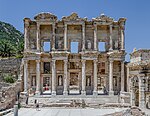
|
İzmir Province 37°55′45″N 27°21′34″E / 37.92917°N 27.35944°E |
Cultural: (iii)(iv)(vi) |
663 (1,640) | 2015 | The ancient Greek city of Ephesus was famed for one of the Seven Wonders of the Ancient World, the Temple of Artemis, which now lies in ruins. After coming under Roman control in the 2nd century BCE, the city flourished, leaving behind monumental structures such as the Library of Celsus. The House of the Virgin Mary and the Basilica of St. John became major Christian pilgrimage sites from the 5th century on.[13] |
| Gordion | 
|
Ankara Province 37°13′00″N 38°55′21″E / 37.21667°N 38.92250°E |
Cultural: (iii) |
1,064 (2,630) | 2023 | Gordion was the capital city of ancient Phrygia. Occupation at the site is attested from the Early Bronze Age (c. 2300 BCE) continuously until the 4th century CE and again in the 13th and 14th centuries CE.[14] |
| Göbekli Tepe | 
|
Şanlıurfa Province 37°13′00″N 38°55′21″E / 37.21667°N 38.92250°E |
Cultural: (i)(ii)(iv) |
126 (310) | 2018 | Dating back to the Pre-Pottery Neolithic age between 10th and 9th millennium BCE, the site was likely used by hunter-gatherers for ritualistic purposes.[15] |
| Göreme National Park and the Rock Sites of Cappadocia | 
|
Nevşehir Province 38°40′00″N 34°51′00″E / 38.66667°N 34.85000°E |
Mixed: (i)(iii)(v)(vii) |
9,884 (24,420) | 1985 | The Göreme Valley area is famous for its striking hoodoo rock formations. The region of Cappadocia also features a gallery of rock-hewn dwellings, villages, churches, underground cities and great examples of post-Iconoclastic Byzantine art.[16] |
| Great Mosque and Hospital of Divriği | 
|
Sivas Province 39°22′17″N 38°07′19″E / 39.37139°N 38.12194°E |
Cultural: (i)(iv) |
2,016 (4,980) | 1985 | Founded in the early 13th century, the mosque-hospital complex at Divriği is a unique and outstanding example of Islamic architecture, blending distinct and sometimes contrasting designs.[17] |
| Hattusha: the Hittite Capital | 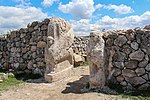
|
Çorum Province 40°00′50″N 34°37′14″E / 40.01389°N 34.62056°E |
Cultural: (i)(ii)(iii)(iv) |
268 (660) | 1986 | The formal capital of the Hittite Empire, with its well-preserved city gates, temples, palaces and the nearby rock sanctuary of Yazılıkaya, is among the last vestiges of the once dominant power in Anatolia and northern Syria.[18] |
| Hierapolis-Pamukkale | 
|
Denizli Province 37°55′26″N 29°07′24″E / 37.92389°N 29.12333°E |
Mixed: (iii)(iv)(vii) |
1,077 (2,660) | 1988 | The natural site of Pamukkale is famous for its visually striking landscape, consisting of petrified waterfalls, stalactites and terraces. The nearby town of Hierapolis, founded at the end of the 2nd century BCE, hosts various Greco-Roman structures including temples, baths, a necropolis, as well as examples of Early Christian architecture.[19] |
| Historic Areas of Istanbul | 
|
Istanbul Province 41°00′30″N 28°58′48″E / 41.00833°N 28.98000°E |
Cultural: (iii)(iv)(vii) |
678 (1,680) | 1985 | The imperial capital of the Byzantine and Ottoman empires, Istanbul has been a major political, religious and cultural centre for more than two millennia. Its skyline, which includes masterpieces such as the Hippodrome of Constantinople, Hagia Sophia, the Süleymaniye Mosque and the Topkapı Palace, testifies to the great geniuses of architects through the ages.[20] |
| Mount Nemrut | 
|
Adıyaman Province 38°02′12″N 38°45′49″E / 38.03667°N 38.76361°E |
Cultural: (i)(iii)(iv) |
11 (27) | 1987 | Mount Nemrut is the location where King Antiochus I (69–34 B.C.) of Commagene constructed his own temple-tomb, surrounded by colossal statues and stelae, in one of the most ambitious architectural undertakings of the Hellenistic period.[21] |
| Neolithic Site of Çatalhöyük | 
|
Konya Province 37°40′00″N 32°49′41″E / 37.66667°N 32.82806°E |
Cultural: (iii)(iv) |
37 (91) | 2012 | Occupied between approximately 7400 BC and 5200 BC, the expansive site of Çatalhöyük is among the few examples of a well-preserved Neolithic settlement, with its egalitarian urban layout, roof-access dwellings, wall paintings and reliefs testifying to a proto-urban way of life.[22] |
| Pergamon and its Multi-Layered Cultural Landscape | 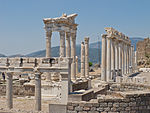
|
İzmir Province 39°07′33″N 27°10′48″E / 39.12583°N 27.18000°E |
Cultural: (i)(ii)(iii)(iv)(vi) |
333 (820) | 2014 | Founded in the 3rd century BC as the capital of the Hellenistic Attalid dynasty, Pergamon was one of the most important cities of the ancient world. After its bequest to the Romans in 133 BC, the city witnessed further development, becoming known as a major therapeutic centre.[23] |
| Selimiye Mosque and its Social Complex | 
|
Edirne Province 41°40′40″N 26°33′34″E / 41.67778°N 26.55944°E |
Cultural: (i)(iv) |
3 (7.4) | 2011 | Constructed during the 16th century, the Selimiye Mosque complex at Edirne is considered by the architect Mimar Sinan to be his masterpiece and represents the highest achievement of Ottoman architecture.[24] |
| Wooden Hypostyle Mosques of Medieval Anatolia | 
|
Countrywide | Cultural: (ii)(iv) |
0.61 (1.5) | 2023 | The site consists of five wooden hypostyle mosques in Anatolia dating back to the late 13th and mid-14th centuries.[25] |
| Xanthos-Letoon | 
|
Antalya and Muğla Provinces 36°20′06″N 29°19′13″E / 36.33500°N 29.32028°E |
Cultural: (ii)(iii) |
126 (310) | 1988 | The site consists of two neighboring settlements. Xanthos, the centre of the Lycian civilization, exerted significant architectural influences upon other cities of the region, with the Nereid Monument directly inspiring the Mausoleum at Halicarnassus in Caria. Letoon, an important religious centre in Lycia, hosts the Letoon trilingual, which provided the key in deciphering the long-extinct Lycian language.[26] |
See also
[edit]References
[edit]- ^ "The World Heritage Convention". UNESCO. Retrieved 8 August 2016.
- ^ "Turkey". UNESCO. Retrieved 15 July 2017.
- ^ "Report of the 9th Session of the Committee". UNESCO. Retrieved 8 August 2016.
- ^ "World Heritage List". UNESCO. Retrieved 28 May 2010.
- ^ "The Criteria for Selection". UNESCO. Retrieved 10 September 2011.
- ^ "Aphrodisias". UNESCO. Retrieved 13 July 2017.
- ^ "Archaeological Site of Ani". UNESCO. Retrieved 8 August 2016.
- ^ "Archaeological Site of Troy". UNESCO. Retrieved 8 August 2016.
- ^ Oldest Swords Found in Turkey
- ^ "Bursa and Cumalıkızık: the Birth of the Ottoman Empire". UNESCO. Retrieved 8 August 2016.
- ^ "City of Safranbolu". UNESCO. Retrieved 8 August 2016.
- ^ "Diyarbakır Fortress and Hevsel Gardens Cultural Landscape". UNESCO. Retrieved 8 August 2016.
- ^ "Ephesus". UNESCO. Retrieved 8 August 2016.
- ^ "Gordion". UNESCO. Retrieved 19 September 2023.
- ^ "Göbekli Tepe". UNESCO. Retrieved 2 July 2018.
- ^ "Göreme National Park and the Rock Sites of Cappadocia". UNESCO. Retrieved 8 August 2016.
- ^ "Great Mosque and Hospital of Divriği". UNESCO. Retrieved 8 August 2016.
- ^ "Hattusha: the Hittite Capital". UNESCO. Retrieved 8 August 2016.
- ^ "Hierapolis-Pamukkale". UNESCO. Retrieved 8 August 2016.
- ^ "Historic Areas of Istanbul". UNESCO. Retrieved 8 August 2016.
- ^ "Nemrut Dağ". UNESCO. Retrieved 8 August 2016.
- ^ "Neolithic Site of Çatalhöyük". UNESCO. Retrieved 8 August 2016.
- ^ "Pergamon and its Multi-Layered Cultural Landscape". UNESCO. Retrieved 8 August 2016.
- ^ "Selimiye Mosque and its Social Complex". UNESCO. Retrieved 8 August 2016.
- ^ "Wooden Hypostyle Mosques of Medieval Anatolia". UNESCO. Retrieved 19 September 2023.
- ^ "Xanthos-Letoon". UNESCO. Retrieved 8 August 2016.

